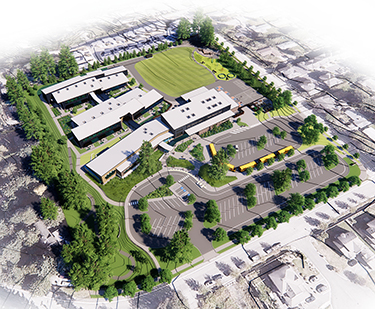|
Subscribe / Renew |
|
|
Contact Us |
|
| ► Subscribe to our Free Weekly Newsletter | |
| home | Welcome, sign in or click here to subscribe. | login |
Architecture & Engineering
| |
 |
March 30, 2023
In Edmonds, a park runs through it
Integrus Architecture

Sachs
|
The proposed design for replacing Oak Heights Elementary School in Edmonds School District sprung from two important early conversations with its design review committee.
The first discussion centered around the lack of parks in this area of Lynnwood in unincorporated Snohomish County. The second occurred while discussing the value that outdoor learning and outdoor connections bring to students and staff, when the school’s Principal Jessie Asp astutely noted that “nature is nurturing.”
Using Asp’s words as a catalyst, the design concept develops a park-like setting and locates the new school within the “park.” The concept prioritizes creating places for student and staff interactions with each other and with the surrounding environment, the emotional and academic benefits from providing fluid indoor-outdoor connections, and publicly facing the outdoor play area so that it is an easily known community asset. The design is based on the foundational principle that engaging with nature is restorative, as well as an understanding of the physical and psychological benefits of natural connections to create feelings of wellbeing and sustain students’ ability to learn.
LEARNING GROWS ON TREES
The positive effects of designing schools within a green and natural environment are well researched and documented. Across the U.S., hundreds of elementary schools (with most in urban locations) have observed predictable and measurable improvements in student learning relative to the amount of “green cover” (specifically tree cover) surrounding the school. The restorative effect of nature on learning is referred to as the nature-academic performance relationship. It is explained by looking at nature’s effect on both cognitive functioning and emotional functioning with benefits gained through even short exposures to nature, such as by looking through a window or during a brief walk between school lessons.
Nature benefits cognitive functioning by allowing students to recover from mental fatigue and allowing their attention to rest. Explained by attention restoration theory (ART), interesting stimuli that attracts us, like nature, engages our involuntary/automatic attention that does not require mental resources. It relieves us from voluntary/directed attention, which requires effort to pay attention and remain focused. A student remaining in sustained, directed attention eventually experiences fatigue, as well as possible negative emotions like irritability that can accompany feeling mentally depleted.
Nature benefits emotional functioning by allowing students to recover from physiological stress. Explained by stress reduction theory (SRT), nature can reduce a student’s blood pressure and stress hormones and refuel the energy used from responding to stress, restoring a feeling of wellbeing.
LEARNING IN A PARK
The design of Oak Heights began with creating three primary outdoor zones for students’ physical, academic, and emotional engagement. From east to west, students move from an active zone to a reflective zone through a middle transition zone. The eastern active zone is defined by its social and energetic play area; the middle transition zone is interactive, facilitating movement between the active and reflective zones; and the western reflective zone is quieter and more natural, connecting the new school to its beloved “forest” at the southwest corner of the site.
The school building is conceived as a series of three separate “bar-shaped” buildings situated in the landscape with space between them to allow the park-like site to run around and through it. Each building stretches lengthwise east to west to optimize daylight through solar orientation. The buildings are subtly angled, both relative to each other and internally, to create dynamic exterior courtyards and interior environments. The three buildings are connected via a central north-south circulation spine, alternating between interior space and exterior covered walkways. The covered walkway connections integrate brief, restorative moments in nature for everyone throughout the school day.
The southernmost building houses the public and community functions of the school. This “public building” presents itself as a welcoming community center and serves as a buffer and filter to the more secure classroom and outdoor zones north of it. It contains the main administration, library, music programs, dining commons, and gymnasium. The central and northern “classroom buildings” contain the core academic learning environments surrounded by natural outdoor courtyards. Each ground level classroom connects to its own covered outdoor learning patio set within the “park” running between and around the buildings. An enclosed skybridge connects the second floor classroom levels across the central academic courtyard.
LEARNING AND HEALING
The nature of learning is fundamentally social, beginning at infancy through our “socially gated” brains and facilitated through interactions and relationships with the people around us. As we grow older, learning continues to be rooted in social engagement, situated in place with students learning in community with one another. A student’s sense of wellbeing is a known critical component to their ability to learn. Today’s schools must be designed not only as program spaces to receive lessons and content, but also as places that foster, sustain, and restore students’ sense of wholeness and wellbeing. To feel whole is to feel complete, to claim your integrity, to retain your dignity, and to experience a sense of belonging.
The two classroom buildings at Oak Heights are designed to support feelings of community and belonging while also maintaining student dignity. Each building is designed around three identifiable learning communities with each containing five classrooms, one or two smaller flex rooms, a central flex learning area, and support spaces including inclusive toilet rooms. The three learning communities are arranged in a split-level design with the one-story eastern community meeting near mid-level the two-story arrangement of the two western learning communities. This split-level approach has many benefits, including minimizing the separation often felt between staff and communities within a two-story school by only needing to move a half-story up or down from the mid-level. This maximizes the number of classrooms at ground level with direct connection to learning outside, and creates a potential fourth learning community where the split level comes together along the central spine.
The flex rooms and surrounding sculpted flex areas within and around each learning community create places to support student wellbeing through intervention and healing-centered engagement. Developed by Dr. Shawn Ginwright, healing-centered engagement aims to holistically restore a student’s sense of wellbeing by focusing on fostering, restoring, and sustaining wellbeing through loving action and promoting feelings of student agency and dignity. The strategically used color palette of blue, green, and violet at Oak Heights creates comfortable and identifiable places nearby for students to reset with the caring adults around them. Healing is experienced collectively. Designed as an environment for healing, inside, outside, and throughout, Oak Heights affords all students the ability to feel whole as individuals and as a community while nurturing cognitive and emotional wellbeing for successful learning experiences.
Loretta Sachs is an associate principal and architect at Integrus Architecture.
Other Stories:
- Engineering gets specialized in response to increasing complexity
- Equitable development: nice to have or essential best practice?
- At Glover Middle School, the lighting runs through it
- Engineering solutions, as waters rise
- Revitalizing downtowns with office-to-residential conversion
- Structures and sustainability: pursuing net-zero carbon emissions
- Employee ownership for all: an alternative to the ESOP
- New form of team work needed for multifamily projects
- So you want to be a rock star (marketer)
- Natural direction is a new path in architecture



